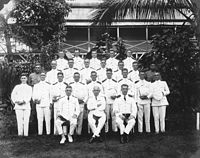About Samoan stuff
So you think that Samoa was always a FREE country?! Well NO - our ancestors had to fight for Freedom!
Read below if you want know some real history you will not easy find outside of Samoa (All details are from wikapedia - not neccessarly 100% correct this is JUST A GUIDE and start - please do your own research and ask your own family.
Black Saturday, 28 December 1929
The new administrator, Stephen Allen, replaced the marines with a special force of New Zealand police, and began to target the leaders of the movement.
Tupua Tamasese Lealofi III, who had led the movement following the exile of Nelson, was arrested for non-payment of taxes and imprisoned for six months.
On 28 December 1929 — which would be known thereafter as "Black Saturday" — New Zealand military police fired upon a peaceful demonstration which had assembled to welcome home A.G. Smyth, a European movement leader returning to Samoa after a two-year exile. Reports of the massacre are sketchy because the official cover-up for the incident was so effective. Tupua Tamasese Lealofi III had rushed to the front of the crowd and turned to face his people; he called for peace from them because some were throwing stones at the police. With his back to the police calling for peace he was shot in the back; another Samoan who rushed to help him was shot in both legs while cradling his head. Another who had attempted to shield his body from the bullets was shot. Two more rushing to help were killed before they could reach him.
Shooting stopped at around 6.30 am. Eight had died, three would later die, and about 50 were wounded. One policeman had also been clubbed to death.
Among the wounded were terrified women and children who had fled to a market place for cover from New Zealand police firing from the verandah of the station, one of them wielding a Lewis machine-gun.
As he lay dying, Tamesese III made this statement to his followers;
My blood has been spilt for Samoa. I am proud to give it. Do not dream of avenging it, as it was spilt in peace. If I die, peace must be maintained at any price.

Following the massacre, male Mau members fled to the mountains, the traditional retreat of those defeated in war. The resistance continued by other means, with the emergence of a women's Mau to continue the councils, parades and symbolic protests that the men now could not. For the women's movement, even the game of cricket represented an act of defiance inviting official harassment.
The day after his funeral, his village was raided by New Zealand military police; they ransacked houses, including those of the Tamasese's mourning widow and children. Colonel Allen requested reinforcements from New Zealand after he claimed 2000 Mau had caused a riot. On 12 January 1930 the Royal New Zealand Navy flagship Dunedin brought marines to hunt down members of The Mau. The Mau, who were fully committed to Passive Resistance, easily slipped through the jungle; the marines were slow because they were carrying too much weaponry and didn't know the bush like The Mau. The Mau no longer trusted New Zealand police, and this fear only got worse after a 16-year-old un-armed Samoan was shot and killed while running away from a marine, whose excuse he thought the boy was going to throw a stone was accepted as an adequate defence and no charges were laid.
A truce was declared on 12 March 1930, after another child was killed by New Zealand marines who were now suffering heat exhaustion and tropical infections. The male Mau members returned to their homes, on the condition that they retain their right to engage in non-cooperation. Meanwhile, Nelson and other exiled leaders continued to lobby the New Zealand Government and communicate their progress to the Mau. In 1931, news of the growing resistance to the British rule of India reached many Samoan villages.


